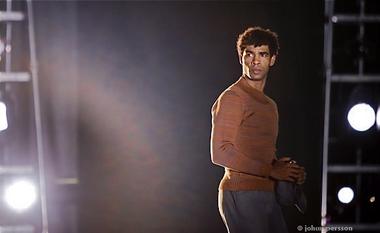Kim Brandstrup
Full Biography by Clement Crisp

A key to the way Kim Brandstup shapes choreography – makes it tell stories, explore moods, stimulate our reactions to movement – lies in his initial interest in cinema, and his formal studies in film at the University of Copenhagen as a young man. The visual drama in the revealing of human relationships, the language established by the camera, have stimulated Brandstrup’s style as a choreographer, and it is important to understand this initial link to his creativity. That dance would later claim him is part of his own realisation that the making of movement would prove more satisfying to his quest for expressive means.
His four years of study with the eminently wise dancer/teacher/choreographer Nina Fonaroff is crucial in the shaping of his dance-style. Fonaroff had been a dancer with Martha Graham, and had then become a vital force in the life of the young London Contemporary Dance School, where Brandstrup worked with her, and found in her a wonderful guide. She taught him to have confidence in his early choreographic essays, and when in 1985 Brandstrup set up his own small company, Arc Dance, his dance-making had an assurance and a clear identity that spoke of a talent already sure of itself. For the stagings which he made during the next two decades, both for Arc Dance and for the increasing number of companies that sought his creations, Brandstrup demonstrated a gift for movement that boasted dramatic intensity and a sure sense of emotional nuance. His Orfeo was cast in a High Baroque style which insisted both on the hero’s sense of isolation and the watchful power of Death (a role brilliantly taken by Kenneth Tharp), and - with its “happy” ending in which the lovers were re-united - a refreshingly generous involvement with his characters.
There were creations from this period which spoke of Brandstrup’s ability to condense and even intensify a dramatic scheme in his choreography, as in his powerful Othello and The Return of Don Juan (both made for Irek Mukhamedov) ,and also to find an allusive or elliptical style to bring a plot to elegant dance-life. His Cupid and Psyche, created for the Royal Danish Ballet, was a full-evening piece which held us with its oblique and fascinating narrative means (as also by its dance), and his Mysteries told of religious beliefs and their outward forms with exceptional finesse. His “commentary” on the life of Hans Christian Andersen in The Anatomy of a Story-teller, and his Antic (which studied aspects of Hamlet’s action) were works which illuminated their themes with an almost insidious skill: choreography exposing narrative in an oblique yet revealing fashion. And this, it must be noted, by means of movement both subtle and penetrating. And, be it also noted, with an economy and a stylishness of decorative means that has ever given a particular elegance, even an austerity, to Brandstrup’s stage.
Since he has sometimes (often, indeed, in his earliest creations) been obliged to produce his work on a restrained – and even severely restricted - budget, his natural sense of the power of a single significant statement to frame his dramatic scheme, has given his productions a finely drawn and evocative framework. His theatre, as we have come to recognise it over the years, is subtle, working by hints rather than declamation, with a discretion of means that can seem understated, but yet retains an undeniable force and penetration into its theme.
At its most remarkable, as in the recent Invitus, Invitam which he made in 2010 for the Royal Ballet at Covent Garden, this has meant a dance-theatre as finely nuanced in its revelations as any I know. Invitus,Invitam is, in many ways, the quintessential Brandstrup creation, its ideas stated through dance both subtle and subtly dramatic, its imagery (in design as in movement) a web of allusions, illusions, emotions suggested rather than proclaimed. This presentation of two lovers (the Emperor Titus and his beloved, Berenice) who must part unwillingly, despite their own desires otherwise, is typical of Brandstrup in its nuances, even its dramatic ambiguities.
As with his earlier piece for the Royal Ballet, Rushes, whose narrative shifts between two lovers and an observer, and whose action is told with most persuasive and emotionally weighted lines of movement, Invitus, Invitam speaks of deepest feelings in the quietest of tones, but those tones can be heard (as the drama can be understood) in the furthest parts of a great Opera House. Brandstrup’s “theatre” in this piece is shadowed, but it is the shadows which serve to reveal emotion, the feelings of its protagonists both hidden by their own uncertainties and revealed because of these uncertainties. Love, duty, the nature of their own feelings and the nature of the other’s feelings as each perceives the other, the necessities of emotional response and a reluctance to state those responses, make for a fascinating, ambiguous and yet ultimately honest display of emotional circumstance. And the inevitability of the lovers’ separation holds like a sustaining thread for the drama itself. The fleet, almost impalpable line of the dance (superlatively stated by Edward Watson and Leanne Benjamin at the first Royal Ballet performance) is played against a setting and a dramatic structure as ambiguous and as satisfyingly shadowed as the choreography.

A theatre allusive, indeed, but the allusions tell us all we should know, and we understand the drama best because of its impalpable, reverberant choreographic forms. This, I feel, is Brandstrup’s distinguishing - and most distinguished – feature as a choreographer. His creativity deals admirably in the nuances and unspoken dramas of human relationships. The language with which he relates his dramas is assured in its manner, deeply sensitive to his interpreters (he has made a fascinating duet which explores and explains the ultra-responsive dance-identities of Alina Cojocaru and Johan Kobborg), and secure in its means. It speaks to us with a real eloquence.
Clement Crisp is dance critic at the Financial Times.